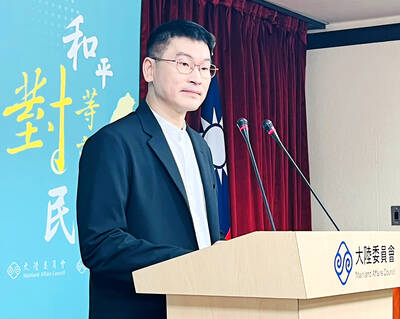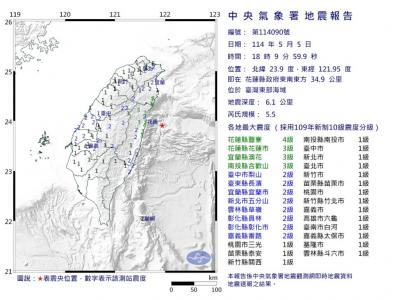A month after the new tobacco regulations took effect, the John Tung Foundation yesterday said it was disappointed with the way health officials had implemented the law, saying officials had caused confusion.
The Tobacco Hazard Prevention and Control Act (菸害防制法), that came into effect on Jan. 11, prohibits smoking in public spaces and offices with three or more employees, as well as requiring businesses to display no-smoking signs. It also limits tobacco marketing activities to a minimum.
The anti-smoking group said yesterday that in the one month since the tobacco ban went into effect, it had received 142 reports of violations. As many as 80 percent, or 110 of the reports, were complaints filed by workers who reporting violations in the workplace.
Yau Sea-wain (姚思遠), president of the foundation, said that because the law prohibits smoking in “offices with three or more employees” and “public indoor spaces,” it would be a violation of the law to smoke in stairways, corridors and restrooms, all of which are commonly mistaken by smokers to be places where smoking is allowed.
“We originally thought that [the complaints] would be mainly about violations in cafes, restaurants, bus and train stations, and outside hospitals. But it turns out that they are mostly about the workplace,” Yau said.
“This is because the government [Bureau of Health Promotion] was unclear about the regulations and not strict enough when it came to implementing the law,” said Yau, who is also dean of the Chinese Culture University’s College of Law.
On day two of the tobacco ban, Bureau of Health Promotion Director-General Hsiao Mei-ling (蕭美玲) said that smoking was allowed outside a 10m radius of hospitals, train and bus stations, school campuses, government agencies, post offices, banks, offices with three or more people, performance halls, movie theaters, hotels, shopping malls and most restaurants. Her comments were made in response to disputes between health officials and businesses and individuals caused by confusion over the “gray areas” of the law.
The foundation slammed the bureau for misinterpreting the law and ignoring the intent of the act. As a result, “the Tobacco Hazard Prevention and Control Act scores only 80 points [out of 100],” Yau said.
“The disputes surrounding the new Tobacco Hazard Prevention and Control Act leave both smokers and non-smokers not knowing what to do,” said Sun Li-chun (孫立群), president of Consumer Reports Taiwan. “It’s disappointing the way [the bureau] enforced the law.”

An essay competition jointly organized by a local writing society and a publisher affiliated with the Chinese Communist Party (CCP) might have contravened the Act Governing Relations Between the People of the Taiwan Area and the Mainland Area (臺灣地區與大陸地區人民關係條例), the Mainland Affairs Council (MAC) said on Thursday. “In this case, the partner organization is clearly an agency under the CCP’s Fujian Provincial Committee,” MAC Deputy Minister and spokesperson Liang Wen-chieh (梁文傑) said at a news briefing in Taipei. “It also involves bringing Taiwanese students to China with all-expenses-paid arrangements to attend award ceremonies and camps,” Liang said. Those two “characteristics” are typically sufficient

A magnitude 5.9 earthquake that struck about 33km off the coast of Hualien City was the "main shock" in a series of quakes in the area, with aftershocks expected over the next three days, the Central Weather Administration (CWA) said yesterday. Prior to the magnitude 5.9 quake shaking most of Taiwan at 6:53pm yesterday, six other earthquakes stronger than a magnitude of 4, starting with a magnitude 5.5 quake at 6:09pm, occurred in the area. CWA Seismological Center Director Wu Chien-fu (吳健富) confirmed that the quakes were all part of the same series and that the magnitude 5.5 temblor was

The brilliant blue waters, thick foliage and bucolic atmosphere on this seemingly idyllic archipelago deep in the Pacific Ocean belie the key role it now plays in a titanic geopolitical struggle. Palau is again on the front line as China, and the US and its allies prepare their forces in an intensifying contest for control over the Asia-Pacific region. The democratic nation of just 17,000 people hosts US-controlled airstrips and soon-to-be-completed radar installations that the US military describes as “critical” to monitoring vast swathes of water and airspace. It is also a key piece of the second island chain, a string of

The Central Weather Administration has issued a heat alert for southeastern Taiwan, warning of temperatures as high as 36°C today, while alerting some coastal areas of strong winds later in the day. Kaohsiung’s Neimen District (內門) and Pingtung County’s Neipu Township (內埔) are under an orange heat alert, which warns of temperatures as high as 36°C for three consecutive days, the CWA said, citing southwest winds. The heat would also extend to Tainan’s Nansi (楠西) and Yujing (玉井) districts, as well as Pingtung’s Gaoshu (高樹), Yanpu (鹽埔) and Majia (瑪家) townships, it said, forecasting highs of up to 36°C in those areas